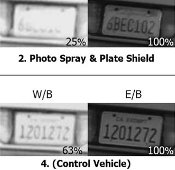Article from: www.thenewspaper.com/news/32/3246.asp
8/30/2010
LAPD Test Finds License Plate Covers, Sprays Ineffective
License plate covers and sprays in some circumstances can make plates more readable.
 The Institute of Transportation Engineers Journal in May published the results of an extensive Los Angeles, California Police Department evaluation of the effectiveness of license plate covers and sprays sold as a means of defeating automated ticketing machines. The test results showed that the popular countermeasures did not work well under actual field conditions using the red light cameras operated in the city by Nestor Traffic Systems (a firm that went bankrupt and was taken over by American Traffic Solutions).
The Institute of Transportation Engineers Journal in May published the results of an extensive Los Angeles, California Police Department evaluation of the effectiveness of license plate covers and sprays sold as a means of defeating automated ticketing machines. The test results showed that the popular countermeasures did not work well under actual field conditions using the red light cameras operated in the city by Nestor Traffic Systems (a firm that went bankrupt and was taken over by American Traffic Solutions).
Thirty-two intersections in Los Angeles are equipped with cameras that use both video and flash photography to dispense $500 tickets to the owners of vehicles photographed turning right on red or entering an intersection as little as a tenth of a second after the light turns red. The machines photograph the driver and the vehicle's rear license plate. The test examined Photoblocker's high-gloss spray that claims to reflect the flash, overexposing the image, as well as a convex license plate cover also designed to reflect the flash. These devices were installed on three 2007 Ford Crown Victorias belonging to the Los Angeles Police Department, with a fourth serving as a control vehicle. The cars were then run through the intersection of Sherman Way and Louise Avenue which were shut down to traffic for the test.
With the signals set to display a constant red light, the cars were run through a total of 160 times in straight-through and turn lanes at night and during the day heading both westbound and eastbound. Night time results were conclusive.
"The countermeasures had no effect on plate legibility under dark conditions, with the exception of V-2 (license plate shield), which occasionally caused a slight increase in front-plate legibility in half of the images," the study found. "All rear plate images were clearly legible, with no significant difference between the test plate images and the control plate image. A citation could have been issued in all cases."
Results from testing at 8am to 9am, however, were less clear with the sun low on the horizon causing a significant amount of glare.
"The countermeasures had very little effect on the rear-plate vehicles, with the exception of the license plate shield, which caused a 38 percent reduction in plate legibility when combined with sun glare," the study found. "The rear plates on the westbound vehicles plates experienced more sun glare than any other group in the test. This is most likely because the angle of the plate in relation to the sun reflected the glare more directly into the camera."
Photoblocker and a generic equivalent decreased legibility in 10 and 20 percent of the cases compared to half of images rendered unreadable with the cover. Headed eastbound, away from the sun, the images were all high-quality regardless of the countermeasures used.
"The overall average image quality scores reveal that the brand-name photo spray and generic lacquer spray both decrease image quality by about five percent, with the brand-name spray having a slight advantage," the study concluded. "The license plate shield shows a five percent overall increase in image quality, which means that when all eight categories are considered equally, this countermeasure had the opposite of the intended effect."
In March 2007, the Discovery Channel's MythBusters television program came to a similar conclusion after testing several types of plate covers against cameras operated by ATS. In June 2008, Pennsylvania's attorney general banned Photoblocker from the state because of the questionable claims made on its website (view ruling).
 The Institute of Transportation Engineers Journal in May published the results of an extensive Los Angeles, California Police Department evaluation of the effectiveness of license plate covers and sprays sold as a means of defeating automated ticketing machines. The test results showed that the popular countermeasures did not work well under actual field conditions using the red light cameras operated in the city by Nestor Traffic Systems (a firm that went bankrupt and was taken over by American Traffic Solutions).
The Institute of Transportation Engineers Journal in May published the results of an extensive Los Angeles, California Police Department evaluation of the effectiveness of license plate covers and sprays sold as a means of defeating automated ticketing machines. The test results showed that the popular countermeasures did not work well under actual field conditions using the red light cameras operated in the city by Nestor Traffic Systems (a firm that went bankrupt and was taken over by American Traffic Solutions).